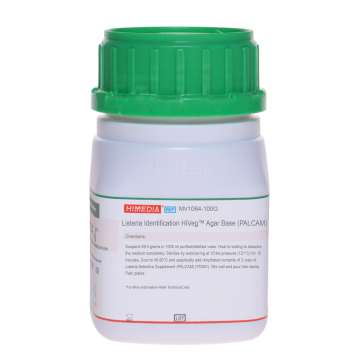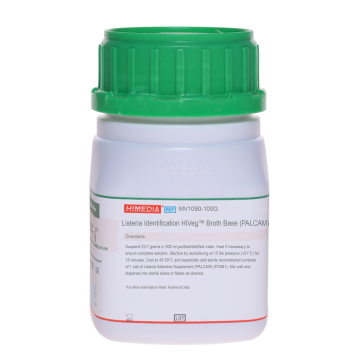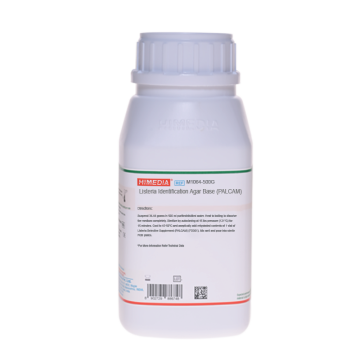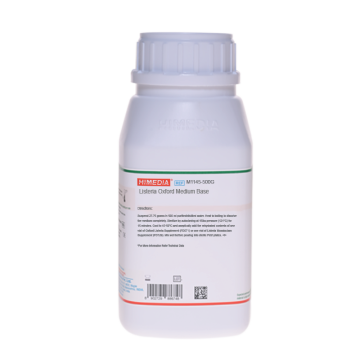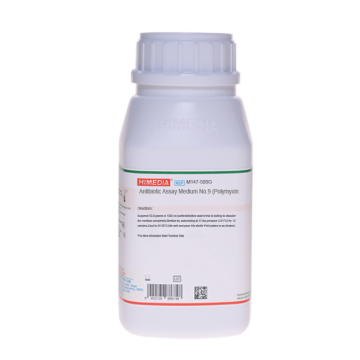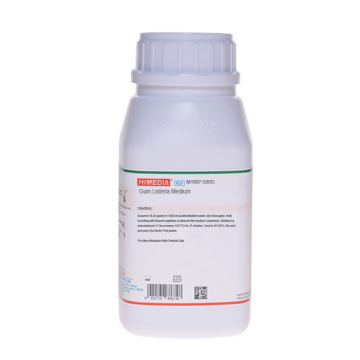 Your enquiry has been submitted
Your enquiry has been submitted
Listeria Selective Agar Base
Intended Use
Recommended for selective isolation and cultivation of Listeria monocytogenes from clinical specimens.
Composition
| Ingredients | g / L |
|---|---|
| Tryptone | 17.000 |
| Soya peptone | 3.000 |
| Yeast extract | 6.000 |
| Sodium chloride | 5.000 |
| Dipotassium hydrogen phosphate | 2.500 |
| Dextrose (Glucose) | 2.500 |
| Agar | 15.000 |
Final pH ( at 25°C): 7.3±0.2
**Formula adjusted, standardized to suit performance parameters
Directions
Suspend 51.0 grams in 1000 ml purified/distilled water. Heat to boiling to dissolve the medium completely. Sterilize by autoclaving at 15 lbs pressure (121°C) for 15 minutes. Cool to 45-50°C and aseptically add rehydrated contents of 1 vial of ANC Selective Supplement (FD063) or 2 vials of ANC Selective Supplement (FD063I) as desired. Mix well and pour into sterile Petri plates.
Principle And Interpretation
Listeria monocytogenes has been isolated from numerous environmental sources such as silage, soil, decaying vegetation, sewage, damp earth, straw and faeces (1,2). Listeria Selective Agar Base with Listeria Selective Supplement is used for isolation and cultivation of L.monocytogenes from clinical specimens. The basic media is formulated as per Lovett et al (3) with the addition of agar.
Tryptone, Soya peptone and yeast extract provide carbon and nitrogen compounds essential for bacterial metabolism. Dextrose is the energy source. The medium is rendered selective by addition of selective supplement. Amphotericin B inhibits the growth of saprophytic fungi. Nalidixic acid inhibits growth of gram-negative organisms and acriflavin suppresses gram-positive microorganisms (4,5).
Listeria monocytogenes is a highly pathogenic organism and proper precautions should be taken while handling.
Type of specimen
Clinical samples - faecal swabs, vaginal swabs
Specimen Collection and Handling
For clinical samples follow appropriate techniques for handling specimens as per established guidelines (6,7). After use, contaminated materials must be sterilized by autoclaving before discarding.
Warning and Precautions
In Vitro diagnostic Use only. For professional use only. Read the label before opening the container. Wear protective gloves/protective clothing/eye protection/ face protection. Follow good microbiological lab practices while handling specimens and culture. Standard precautions as per established guidelines should be followed while handling clinical specimens. Safety guidelines may be referred in individual safety data sheets
Limitations
- Individual organisms differ in their growth requirement and may show variable growth patterns on the medium.
- Each lot of the medium has been tested for the organisms specified on the COA. It is recommended to users to validate the medium for any specific microorganism other than mentioned in the COA based on the user’s unique requirement.
- The medium is not differential, so further biochemical testing is required for identification between Listeria species.
Performance and Evaluation
Performance of the medium is expected when used as per the direction on the label within the expiry period when stored at recommended temperature.
Quality Control
Appearance: Cream to yellow homogeneous free flowing powder
Colour and Clarity of prepared medium: Fluorescent yellow coloured, clear to slightly opalescent solution.
Reaction: Reaction of 5.1% w/v aqueous solution at 25°C. pH : 7.3±0.2
pH: 7.10-7.50
Cultural Response: Cultural characteristics observed after an incubation at 35-37°C for 24-48 hours.
| Organism | Inoculum (CFU) | Growth | Recovery |
|---|---|---|---|
| Listeria monocytogenes ATCC 19118 | 50-100 | luxuriant | >=50% |
| Listeria monocytogenes ATCC 19112 | 50-100 | luxuriant | >=50% |
| Listeria monocytogenes serovar1 ATCC 19111 (00020*) | 50-100 | luxuriant | >=50% |
| Escherichia coli ATCC 25922 (00013*) | >=104 | inhibited | 0% |
| Candida albicans ATCC 10231 (00054*) | >=104 | inhibited | 0% |
| Staphylococcus aureus subsp. aureus ATCC 25923 (00034*) | 50-100 | none-poor | <=10% |
Storage and Shelf Life
Store between 10-30°C in a tightly closed container and the prepared medium at 2-8°C. Use before expiry date on the label. On opening, product should be properly stored dry, after tightly capping the bottle in-order to prevent lump formation due to the hygroscopic nature of the product. Improper storage of the product may lead to lump formation. Store in dry ventilated area protected from extremes of temperature and sources of ignition Seal the container tightly after use. Product performance is best if used within stated expiry period.
Disposal
User must ensure safe disposal by autoclaving and/or incineration of used or unusable preparations of this product. Follow established laboratory procedures in disposing of infectious materials and material that comes into contact with clinical sample must be decontaminated and disposed of in accordance with current laboratory techniques (6,7).
Reference
- Gray M. L., 1960, Science, 132:1767.
- Weis J., and Seeliger H. P. R., 1975, Appl. Microbiol. 30:29.
- Lovette J., Francis D.W and Hunt J.M., 1987, J. Food Protection, 50:188.
- Lee W.K. and McClain D., 1986, Appl. Environ, Microbiol., 52:1215.
- McClain D. and Lee W.H., 1988, J. Assoc. off. Anal. Chem., 71:660.
- Isenberg, H.D. Clinical Microbiology Procedures Handbook 2nd Edition.
- Jorgensen, J.H., Pfaller, M.A., Carroll, K.C., Funke, G., Landry, M.L., Richter, S.S and Warnock., D.W. (2015) Manual of Clinical Microbiology, 11th Edition. Vol. 1.
| Product Name | Listeria Selective Agar Base |
|---|---|
| SKU | M1474 |
| Product Type | Regular |
| Physical Form | Powder |
| Origin | Animal |
| Packaging type | HDPE |
| References | 1. Gray M. L., 1960, Science, 132:1767 |
| Customized Product Available | No |




